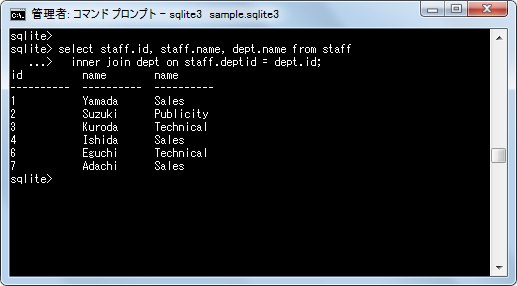
table_name - select the column "i" from the table function "range", where the first column of the range function is renamed to "i" SELECT t.
#SQLITE INNER JOIN ON SUBQUERY FREE#
No coding experience? No problem. Learn SQL and Python using real-world data with our free tutorials.- select all columns from the table called "table_name" FROM table_name - select all columns from the table called "table_name" SELECT * FROM table_name - select all columns from the table called "table_name" in the schema "schema_name SELECT * FROM schema_name. LEFT JOIN the subquery (aliased as a) on sales_rep_id.įinally, exclude sales reps that are associated with an order in your subquery by adding a WHERE a.order_id is NULL clause. In this case, you'll pull each sales rep's id, name, and region id. Select the columns you want from the sales reps table. You'll be able to join this subquery to a table just like you would join a table to a table. Now you've got the two things you need: a table containing a record of all sales reps ( demo.sales_reps) and a subquery that pulls a record of the sales rep associated with all orders that occurred over the specified time range. WHERE o.occurred_at BETWEEN '' AND ' 23:59:59' Since this table doesn't exist already, you'll need to start by creating a subquery. While you already have your primary table containing records of all sales reps ( demo.sales_reps), you'll need a second table containing a record of all sales reps who did close a deal during the time range in order to perform your anti join. Which sales reps didn't close a deal from September 5th - September 15th?įor this query, you'll use three tables: demo.accounts, demo.orders, and demo.sales_reps. LEFT JOIN the web events table to the accounts table on the account_id, for visits that occurred in 2016:ĪND we.occurred_at BETWEEN '' AND ' 23:59:59'Įxclude accounts that did visit the website in 2016 by adding a WHERE we.id is NULL clause. The second table ( demo.web_events) has a record of every web visit. The first table ( demo.accounts) has a record of all customer accounts. Which customers haven't visited your website this year? LEFT JOIN the orders table to the accounts table on the account_id, for orders that occurred in August 2016.ĪND o.occurred_at BETWEEN '' AND ' 23:59:59'Įxclude accounts that did place an order in August by adding a WHERE o.id is NULL clause. Select the columns you want from the accounts table: id (aliased as customer_id) and name (aliased as customer_name). The second table ( demo.orders) has a record of every order. Which customers didn't place an order in August? Just sign up for an account and click here to write a new query against the tables in the Mode Public Warehouse. Try working through these three business situations on your own in Mode. Once you've got the basics down, you can solidify your knowledge by practicing on real-world data. The entire query will return only values that are in Table_1 but not in Table_2. SELECT * FROM Table 1 t1 LEFT JOIN Table2 t2 ON t1.id = t2.id WHERE t2.id IS NULL Use a WHERE clause to filter out values that are present in Table_2. SELECT * FROM Table 1 t1 LEFT JOIN Table2 t2 ON t1.id = t2.id By using a LEFT JOIN, your query will return all values from Table_1 (whether or not they are also present in Table_2). LEFT JOIN Table_2 to Table_1 and assign Table_2 an alias: t2. To find all the values from Table_1 that are not in Table_2, you'll need to use a combination of LEFT JOIN and WHERE. Unlike most SQL joins, an anti join doesn't have its own syntax - meaning one actually performs an anti join using a combination of other SQL queries.
#SQLITE INNER JOIN ON SUBQUERY HOW TO#
We will walk through how to use an anti join, using a left anti join.

: This join returns rows in the right table that have no matching rows in the left table. : This join returns rows in the left table that have no matching rows in the right table. We'll walk through each of these situations later on, but first, here's a primer on the types of anti joins and how to write them. They can be helpful in a variety of business situations when you're trying to find something that hasn't happened, such as:Ĭustomers who have not visited your website But, get over this conceptual speed bump, and you're well on your way to becoming proficient at SQL.Įven after learning the principles of inner, outer, left, and right joins, you might still have a nagging question: how do I find values from one table that are NOT present in another table? You're breezing through SELECT statements and comparison operators and ORDER BY, and wham! you run smack into joins.

Anyone who has tried to learn SQL knows it's tricky to get the hang of joins.


 0 kommentar(er)
0 kommentar(er)
